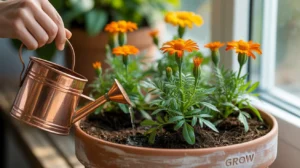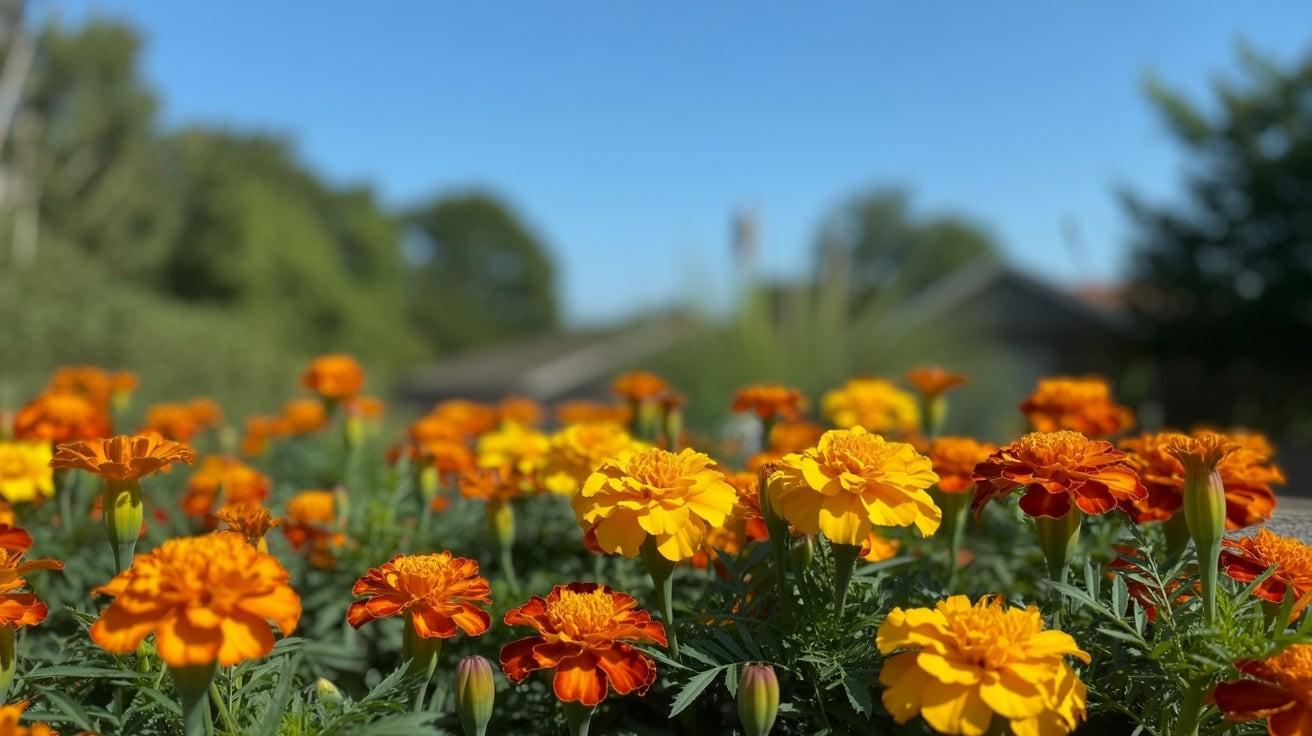Want a flower that’s easy to grow, adds instant color, and protects your garden naturally? Meet the marigold — a garden favorite that’s as tough as it is beautiful.
The secret to long-lasting blooms and healthy plants lies in one simple thing: proper marigold care. These fiery orange and golden yellow flowers aren’t just pretty faces. They grow fast, handle heat like a pro, and even scare away garden pests without any chemicals. But to get the best out of your marigolds, you need to know how to care for them the right way.
Whether you’re planting in a sunny backyard, a tiny balcony, or just a pot by the window, this guide will show you step-by-step marigold care that works for every space and every season. From picking the right variety to watering, pruning, and keeping bugs away — we’ll cover it all.
If you’re starting fresh or just want more blooms with less effort, mastering marigold care is the smart move every gardener should make.
Table of Contents
ToggleChoosing the Right Type of Marigold Plant
When it comes to proper marigold care, your first step should always be choosing the right type of marigold plant for your garden. Each variety has its own strengths — some bloom bigger, others stay compact, and some even have edible petals. Understanding the differences can help you plant with purpose and get better results.
French Marigolds
French marigolds are small, neat, and incredibly reliable. They grow low to the ground, making them perfect for garden borders, containers, and balconies. Their blooms are vibrant and long-lasting, and they thrive in both sun and partial shade. If you’re new to gardening or want something low-maintenance, French marigolds are a smart pick. With minimal effort, they’ll reward you with steady flowers throughout the season. Consistent marigold care like light watering and full sun will keep them blooming non-stop.
African Marigolds
African marigolds, also known as Tagetes erecta, are tall, bold, and eye-catching. Their large, round flowers make them ideal for flower beds, where they can stand tall among other plants. These marigolds love full sunlight and rich soil, and they require a little more space than other types. If you want something that makes a strong visual impact, African marigolds are your go-to choice. Just be sure to give them proper marigold care, including regular deadheading, to promote longer bloom periods.
Signet Marigolds
Signet marigolds are the most delicate of the bunch, but don’t let that fool you. Their fine leaves, citrusy scent, and edible flowers make them a unique addition to herb gardens, patio containers, and even vegetable plots. These marigolds are drought-tolerant and thrive in poor soil conditions, making them a great option for hot and dry climates. With light, consistent marigold care, they will fill your garden with a soft fragrance and charming blooms.
All types of marigold plants—French, African, or Signet—are easy to grow, fast to flower, and naturally resistant to many pests. No matter which variety you choose, applying the right marigold care methods will ensure they stay healthy and full of blooms all season long. From choosing the right type to giving them the right soil and sunlight, a little attention goes a long way in helping your marigolds thrive.
How Much Sunlight Do Marigold Plants Need?
Sunlight is one of the most essential parts of good marigold care. If you’re wondering how much sun marigolds need, the simple answer is — a lot. Marigolds need at least 6 to 8 hours of direct sunlight every single day to grow healthy and bloom beautifully. These plants are sun-lovers, and their best growth happens in full sun. Without it, even strong soil and proper watering can’t help them reach their full potential.
When marigolds are planted in shady areas or don’t get enough light, they start showing clear signs of stress. Their stems stretch out, becoming long and weak — a condition known as being leggy. This makes the plant floppy and unstable. The number of flowers also reduces, and those that bloom will have dull and faded colors. So, if you’re serious about marigold care, avoid planting them where shade dominates the day.
Many new gardeners ask, can marigolds grow in shade? Technically, yes, but they won’t thrive. You’ll see fewer flowers, weaker stems, and slower growth. For full bloom and color, marigolds need full sunlight — whether you’re planting them in garden beds, raised planters, pots, or containers.
When choosing the best place to plant marigolds, go for an open area that receives consistent daylight. This could be a sunny garden corner, an east or south-facing balcony, or even a bright windowsill indoors. If you’re growing them inside and natural light is limited, a grow light can help provide the necessary brightness.
In short, sunlight powers everything for marigolds. It boosts their flowering, strengthens their stems, and keeps their colors bold and beautiful. Consistent light exposure also makes your entire marigold care routine easier, as healthy plants are more resistant to pests and diseases.
Whether you’re growing African marigolds, French marigolds, or Signet marigolds, the sunlight requirement stays the same. For lush flowers and strong growth, give them a bright home and they’ll reward you with color all season long.

Soil and Potting Mix for Healthy Marigold Plants
Getting the soil right is a big part of successful marigold care, and while marigolds are known for being low-maintenance, they still grow better when planted in the right type of soil. If you want bright flowers, fast growth, and a plant that stays healthy all season, you need to focus on what’s happening below the surface — in the roots.
The ideal soil for marigold plants is well-drained, loose, and slightly rich with organic material. These plants don’t like sitting in wet or soggy soil. In fact, if their roots stay wet for too long, they may start to rot, and that can kill the entire plant. That’s why choosing soil with good drainage is key — it lets water pass through quickly and gives roots enough oxygen to breathe.
In terms of texture, loamy or sandy soil is perfect. These types of soil stay light and don’t become compacted, which helps the plant develop strong roots. Heavy clay soils, on the other hand, can hold too much water and restrict root growth. If your garden has clay soil, it’s better to mix in compost or coarse sand to loosen it up.
Another important factor in marigold care is the soil’s pH level. Marigolds thrive in soil with a pH between 6.0 and 7.0, which is just slightly acidic to neutral. If the soil is too acidic or alkaline, the plant won’t be able to absorb nutrients properly — no matter how much you fertilize. You can use a simple home soil test kit to check this and adjust it with additives like lime or sulfur if needed.
If you’re growing marigolds in containers or pots, use a lightweight potting mix that includes ingredients like peat moss, perlite, or composted bark. These mixes are specially made to hold just the right amount of water while letting the excess drain away. Avoid using plain garden soil in pots because it’s too heavy and may cause poor root development or waterlogging.
High-quality soil makes everything else in your marigold care routine more effective — from watering and feeding to flowering and disease resistance. So, whether you’re planting them in the ground or in containers, investing a little effort into the right soil setup can mean the difference between a struggling plant and one bursting with color.
Watering Tips: Keep Your Marigold Plants Thriving with Just the Right Moisture
One of the most common questions in marigold care is this: How much water do marigolds really need? The answer is simple but important — marigolds love balance. Give them too little water, and they’ll dry out. Give them too much, and their roots may rot. To grow strong, colorful, and healthy, marigold plants need a smart watering routine that matches where and how you grow them.
For marigolds planted in garden beds, water them deeply once or twice a week, depending on the weather. A deep watering means you soak the soil enough so the water reaches the roots. But always check the soil before watering. Gently press your finger into the top inch — if it feels dry, it’s time to water. If it’s still moist, wait a little longer. Overwatering is one of the biggest mistakes in marigold care.
Now if you’re growing marigolds in pots, the rules change a bit. Pots dry out faster than ground soil, especially during hot summer days. In this case, you may need to water every other day or even daily — but only if the top layer feels dry. Use containers with drainage holes to make sure extra water escapes and doesn’t sit at the bottom, causing root rot.
Another tip that gardeners often overlook is how you water. Never pour water over the leaves. This can lead to leaf spots, mold, or fungus. Instead, always water at the base of the plant, close to the soil, where the roots actually absorb it.
Many people search online asking, “Can you overwater marigolds?” and the answer is absolutely, yes. If your marigold leaves turn yellow, look soft, or the plant starts to wilt even when the soil seems wet, that’s a clear sign of too much water. Marigolds don’t like soggy soil. They prefer it a little dry between watering sessions — they are much better at surviving short dry spells than sitting in wet dirt.
The best time to water marigolds is early morning or late afternoon. Watering during the heat of the day can cause water to evaporate too quickly, while watering late at night can increase moisture on leaves, which may lead to fungus.
Smart, balanced watering is a key part of proper marigold care. If you follow these tips — and adjust based on the weather, season, and whether you’re growing in containers or the ground — your marigolds will reward you with bold colors, healthy foliage, and non-stop blooms.

Mastering Marigold Care: Prune, Deadhead, and Feed the Right Way
When it comes to growing bold, beautiful flowers, marigold care plays a huge role in how long your plants stay healthy and how many blooms they produce. If you want your garden or pots full of glowing orange and golden petals, you’ll need to know how to deadhead, prune, and feed your marigolds the smart way.
First up: deadheading. One of the simplest but most powerful marigold care tips is removing old flowers. Once the blooms dry out and begin to fade, the plant stops focusing on making new flowers and shifts to seed production. That means fewer blooms for you. To keep the plant focused on flowering, snip off those old blooms regularly. Use your fingers or a small clean pair of scissors. This encourages your marigold plant to create fresh blossoms again and again.
Next is pruning, another key step in excellent marigold care. If your plant starts growing too tall or thin, trimming some of the longer stems can help. Pruning not only improves the plant’s shape but also stimulates new growth from the sides, making your marigold bushier and more vibrant. This is especially useful if your marigold plant starts looking tired or overgrown halfway through the season.
And don’t forget to feed your marigolds, because the right nutrition supports everything else. While marigold plants aren’t heavy feeders, they still benefit from some extra care. Add organic compost or manure before planting to enrich the soil. Once a month, use a balanced fertilizer — like 10-10-10 — but never overdo it. Too much fertilizer harms your marigolds, leading to leafy growth with few flowers, which is the opposite of what we want.
All in all, proper marigold care means being consistent with your plant’s needs. When you prune at the right time, remove dead flowers regularly, and give just the right amount of nutrients, your marigold plants reward you with long-lasting color and healthy growth all season long. These small habits make a big difference — and turn basic gardening into something truly beautiful.
Strong Marigold Care: Healthy Blooms & Pest-Free Plants in Any Space
Good marigold care means more than just planting a seed. It’s about giving your marigold plant what it needs to grow healthy, stay bright, and live long. Even though marigolds are tough and easy to grow, they still need a little help from you to avoid bugs and grow well — especially if you’re planting in a small space or inside a container.
Let’s talk about pests. Even the strongest marigolds sometimes face problems like aphids, spider mites, or slugs. These pests try to suck the plant’s juice or eat the leaves. This can slow down growth and make the plant look weak. For good marigold care, you need to keep an eye out for early signs. Look at the leaves often. If you see them turning yellow, curling, or getting white spots, it might mean pests are around.
But don’t worry — with smart marigold care, these problems are easy to handle. Spray your marigolds once a week with neem oil, a natural way to fight bugs. Make sure the plants have space around them so air can move freely — this helps prevent diseases like powdery mildew. Also, only water the soil — not the leaves — because wet leaves can cause fungus to grow.
Now let’s say you’re growing your marigolds in pots. Great choice! Marigolds grow really well in containers. For the best marigold care in pots, choose small types like French marigolds, and use a pot with holes so extra water can drain. Put the pot in a sunny spot — like a balcony or a window — and water when the top of the soil feels dry. Just don’t flood it, because marigolds like slightly dry soil, not soggy roots.
When you follow these simple steps for marigold care, your plants will stay strong, green, and full of colorful flowers. Whether you grow them in a backyard, on a balcony, or even by a windowsill, healthy marigolds brighten up any space and keep pests away from other plants, too. That’s why gardeners love them!
Grow & Care Like a Pro: Year-Round Marigold Care From Seed to Season
If you really want your garden to pop with color, learning proper marigold care is the best place to start. These flowers are bright, cheerful, and super easy to grow — even from tiny seeds. Whether you’re a new gardener or someone who’s been growing plants for years, marigold care is simple enough for anyone to handle, yet rewarding enough to bring joy to every corner of your garden.
Let’s start with seeds. Growing marigolds from seed is not only budget-friendly but also gives you full control over their health. After the last frost, just press the seeds gently into moist soil — don’t bury them too deep. Keep the area slightly wet (but not soggy), and in about 5–7 days, you’ll see small sprouts reaching for the sun. This is where your real marigold care begins. As your plants grow taller, remove the weaker sprouts so the strong ones can bloom better and faster. With a little patience, your marigolds will reward you with colorful flowers in about 6 to 8 weeks.
Now let’s talk about what happens when the weather changes. During the cold season, especially in places with frost, marigold care becomes more about planning for the future. These plants usually finish their life cycle by winter, but that doesn’t mean the beauty has to end. Once the blooms start drying out, gently collect the seeds and store them. It’s like saving sunshine for next spring. In warmer areas, your marigold care routine can continue even during the winter — just make sure your plants still get sunlight and aren’t overwatered. A little pruning now and then helps them stay fresh and full of life.
Proper marigold care isn’t just about watering or sunlight — it’s about understanding the plant’s needs through every stage. From planting seeds to seasonal changes, each step helps your marigolds thrive longer and bloom brighter. The good news? These flowers don’t demand a lot. They just need your attention, your care, and a sunny spot to shine in.
If you follow the right marigold care tips from the beginning, you won’t just grow flowers — you’ll grow confidence in your gardening skills too. Whether you’re planting in pots, beds, or even small balcony spaces, consistent marigold care makes a huge difference. With every new bloom, you’ll see how simple efforts bring beautiful rewards.
Conclusion
If you’re looking for a flower that’s bright, cheerful, and super easy to grow, marigold plants are the perfect pick. With just a little sunlight, water, and the right marigold care, you’ll enjoy beautiful orange and yellow blooms almost every day. These flowers are great for beginners and work well in both garden beds and pots.
The best part? Marigold care is simple. They grow fast, fight off pests naturally, and don’t need much fertilizer. Whether you have a sunny balcony or a backyard, marigolds can turn any space into a colorful, blooming garden.
People often search for easy flowers for pots or low-maintenance garden plants — and marigolds always top the list. If you follow the right marigold care steps, your garden will stay full of life and beauty all season long.
Add marigolds to your space today — they’re a joy to grow and a treat to see!



